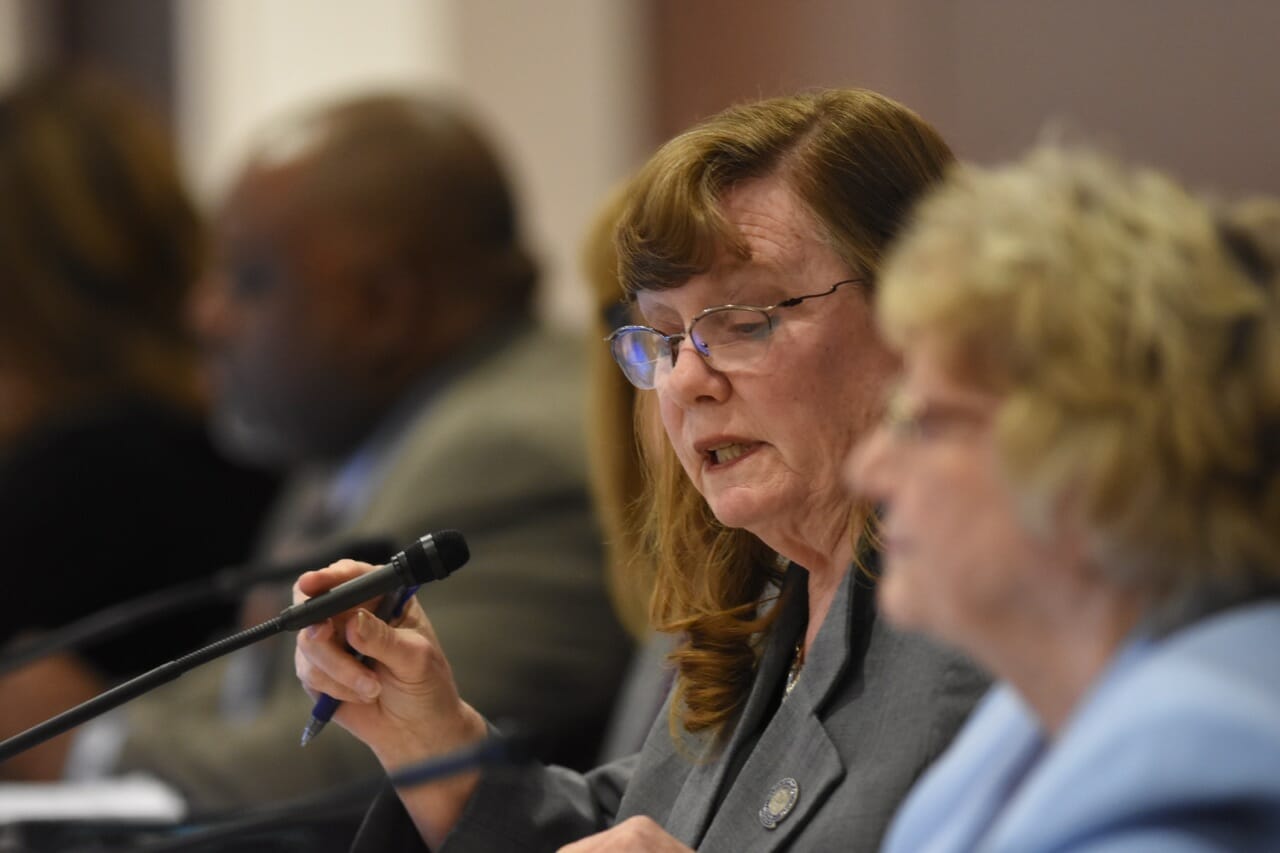Lawmakers finish the heavy lifting on the state budget

Lawmakers are finalizing the hefty task of combing through Republican Gov. Brian Sandoval’s $8.1 billion, two-year budget recommendation and making changes to it.
Senate and Assembly money committees met on Saturday to vote on individual department budgets and reconcile the few disagreements between committees in the two houses. Their decisions will be incorporated into bills that will go before the full Senate and Assembly for votes near the end of the session, which must end by June 5.
Within a few days, lawmakers should know how much revenue is available to them for expenses that go beyond the base budget. There are plenty of pending bills that cost money and may get funding if there are enough leftovers, especially after the state’s Economic Forum projected higher-than-expected revenue earlier in May.
Here are some of lawmakers’ most significant decisions:
EDUCATION:

Legislators approved spending from the state’s biggest education accounts that’s $76.1 million less than the governor’s recommended budget. That could make way for other education-related spending projects.
Lawmakers approved $2.3 billion in spending over the next two years for the Distributive School Account (basic education funding), which will help the state support K-12 students at an average rate of $5,900 each in the first year of the biennium and $5,967 each in the second year. Local funding typically supplements the state support.
The state is projecting a “weighted” enrollment of 476,338 in the first year of biennium, which marks 1.05% growth, and 482,292 in the second year of the biennium, which represents 1.25% growth.
The budget also contains revised projections of recreational marijuana revenue expected through a 10 percent proposed excise tax on sales. The state now expects $64 million over the two-year budget, which will go to the Distributive School Account.
Lawmakers reauthorized a slate of education initiatives proposed by Gov. Brian Sandoval in 2015, including:
-
- $44.6 million over the biennium for Read by Grade 3 grant program, which helps schools implement literacy programs.
- $22.4 million over the biennium for social workers in schools, who are a key element of the state’s anti-bullying efforts. They also approved flexibility so schools can hire social workers as employees with benefits to help with retention, or hire them as contractors, which is the existing arrangement.
- $20 million over the biennium for Nevada Ready 21 technology grants, which provide middle-schoolers a state-funded laptop and fund professional development so teachers can make the most of them.
- $10 million over the biennium to continue College and Career Readiness grant program, which funds efforts to increase participation in Advanced Placement (AP) classes, promote dual enrollment in high school and college courses, and implement Science, Technology, Engineering and Math (STEM) programs.
- $4.4M over the biennium for Gifted and Talented Education (GATE).
They rejected Sandoval’s original proposal to put $72 million to expand the Zoom Schools and Victory Schools programs, instead setting it aside for other education initiatives, such as a pending effort to implement a “weighted” school funding formula.
They approved $299.5 million over biennium to continue the class-size reduction program, which keeps the student-teacher ratio down to 17:1 in grades 1 and 2, and 20:1 in grade 3.
The committee also approved spending $2.9 million over two years to create “pathway” high school diplomas, which would have higher standards and be more closely aligned to career readiness goals. The policy portion comes in the form of AB7, which allows students to earn “endorsements” in certain topic areas. The funds would also be used to pay for a contract for a public awareness campaign.
CORRECTIONS:
Lawmakers approved spending $5.8 million less over the biennium than originally planned. Some highlights in the Department of Corrections budget:
- Bed Shortage and Private Prisons: Because of growing prison populations and temporary closures due to renovations, Nevada prison officials estimate a bed shortage of 324 in 2018 and 754 in 2019. Officials say a number of initiatives and criminal justice reform bills in the Legislature could reduce the population by several hundred inmates, and budget committees approved spending $11.4 million to transfer 200 inmates to out-of-state private prisons. Republican Sen. Ben Kieckhefer noted that the state was still expecting more prisoners than available beds, and that a last-minute request for additional funds could eat up a significant portion of emergency funds budgeted for the Interim Finance Committee. “I have concerns about budgeting a shortfall,” he said.
- Body and stationary cameras: Lawmakers approved about $1.8 million over the biennium to fund 71 body cameras and 312 stationary cameras in prisons.
- Prison medical costs: Lawmakers budgeted $35.6 million over the biennium for inmate health care.
PAROLE AND PROBATION:
Lawmakers approved spending $7.6 million more than initially planned for the Division of Parole and Probation. Some of the expenses include:
- Day Reporting Centers: Lawmakers approved $2.7 million over the biennium to add eight full-time positions for incarceration alternatives, including Day Reporting Centers where parolees can get extra supervision and resources to transition back into the community.
- Re-Entry Program and Transitional Housing: Lawmakers approved $3.4 million over the biennium to support a pilot re-entry program, a state-funded electronic monitoring program, a state-funded transitional housing program, and the addition of 16 positions to support these efforts.
- More Meetings for Pardons Board: Lawmakers approved $118,111 over the biennium for a new administrative assistant position to support the Pardons Board. That would allow the board to meet more frequently and consider a high volume of requests for pardons.
STATE PARKS
Legislators approved a Department of Conservation and Natural Resources budget that’s $1.1 million less than the governor’s recommendation. It adds staff to manage several expanded and new state parks, including:
-
- Walker River State Recreation Area: Made up of more than 12,000 acres of ranch land in rural Lyon County that was donated to the state, legislators approved funding for a dozen new positions and other operational costs totaling roughly $4.8 million. It also approved nearly half a million to build a campsite at the new park. The committee also approved spending $100,000 transferred over from the state’s highway fund to maintain gravel roads within the park. Kieckhefer tried to convince the committee to pay another $90,000 to install flush toilets at the new park instead of outhouse-style “vault” toilets, but lawmakers denied the request, saying they wanted to wait and see what kind of tourist traffic the new park brings in.
- Tule Springs State Park: Another new state park located on 315 acres of state-owned land near the existing Tule Springs Fossil Beds National Monument in Southern Nevada. Legislators approved $1.6 million to establish the park, including two permanent and two seasonal positions.
- Wi-Fi: The budget also includes funding for 13 new positions in existing state parks, and maintenance and construction projects including Wi-Fi availability at 8 state parks.
MENTAL HEALTH:
- Desert Willow children’s psychiatric center will remain open: Lawmakers rejected the governor’s recommendation to close this 58-bed psychiatric facility in Las Vegas and start maintaining 20 children’s psychiatric beds in Rawson-Neal an adult hospital on the same campus. Instead, the state will maintain enough staff to have 20 youth beds open within Desert Willow, and allow a private operator to come and manage the remaining 38 beds. The move is expected to save the state $3 million over the biennium, less than the $3.2 million it would’ve saved by totally closing Desert Willow and allowing it to be leased to someone else.
CAPITAL IMPROVEMENT PROJECTS:
Lawmakers approved a list of capital improvement projects that amount to about $9 million more than the original governor’s $345 million recommendation. Among them:
-
- UNR Engineering Building: Complete design and construction of a new, 86,000-square-foot engineering building at UNR that would include 40 research laboratories, 3 instructional laboratories, classrooms, a computer lab, 50 offices, and 150 graduate student workstations. $41.5 million will come from state-issued general obligation bonds, with university funds supplying another $43 million.
- UNR Engineering Building: Complete design and construction of a new, 86,000-square-foot engineering building at UNR that would include 40 research laboratories, 3 instructional laboratories, classrooms, a computer lab, 50 offices, and 150 graduate student workstations. $41.5 million will come from state-issued general obligation bonds, with university funds supplying another $43 million.
- Planning for future construction projects as Southern Nevada colleges:

Legislators unanimously approved two out of three planning projects for Southern Nevada universities and colleges designed to address workforce needs in engineering, health care and teaching. While legislators split the initial planning costs between themselves and the individual schools, future construction costs would likely be upward of $100 million.
-
- UNLV Engineering Building: The school is seeking $4 million to plan for a new, 50,000-square-foot building. The schools say engineering was one of their fastest-growing programs. Construction costs would be about $31.4 million, with the state paying 60 percent and the university paying 40 percent. The committee deferred taking action on this project.
- College of Southern Nevada health sciences building: The college is seeking to build a new, 70,000-square-foot building on or near its Henderson campus. It would be used by both CSN and Nevada State College and would cost $4.4 million in the planning phase and $41 million for construction. The school pointed out that Nevada has a need of 15,000 nurses and health technicians, according to the Governor’s Office of Economic Development. Legislators approved using the state’s bonding authority to fund the state’s portion of the initial planning phase.
- Nevada State College education building: The college is also aiming to either construct or renovate an existing building into a new, 65,000-square-foot building. The project’s planning costs would be around $2.4 million, with another $1 million for renovating an existing building or leasing another property. Construction would cost around $21 million total, with the college kicking in up to $6 million for both planning and construction. The committee approved using existing state dollars from the general fund to pay for the planning portion of the project.
- Northern Nevada Veterans Home: State funds of $36 million are fronting the cost of construction because of delays in approved funding from the federal government. The 102,000-square-foot, 96-bed veterans nursing facility on the grounds of the Northern Nevada Adult Mental Health Services campus will serve veterans, spouses of veterans and Gold Star Parents who had a child who died while in military service. If Congress approves federal funding for the project in the future, the state would be reimbursed for up to $33.1 million. State officials said they have no way of knowing when the state will be reimbursed by the federal government. The home is expected to open in January 2019.
- Renovation of the Stewart Indian School Cultural Center and Welcome Center at the Stewart Campus: This project is a renovation of historic buildings deeded to the state by the federal government. The 7,100-square-foot Cultural Center would display memorabilia, house interpretative exhibits, provide research facilities, celebrate the arts, and tell the history of the Stewart Indian School. The Welcome Center would be an information center. The state will be paying $4.5 million over the biennium.
- Department of Motor Vehicles office in South Reno. This project recommends the closure of the existing Galetti Way office with the consolidation of all DMV offices into one, 58,000-square-foot South Reno facility. The $42 million will come from Highway Funds and completion is scheduled for 2020. DMV Director Terri Albertson said the existing office has 159 employees but only 152 parking spaces for both employees and customers, according to the Nevada Appeal. In 2016, there were 1,500 parking citations and 566 vehicles towed because of lack of space. The new office would have three times the parking spaces.
- National Guard Readiness Center in North Las Vegas. The 78,000-square-foot facility would include administration offices, storage, classrooms, locker rooms a break area, restrooms/showers and parking for soldiers of the 17th Sustainment Brigade and the Explosive Ordnance Disposal company of the Nevada Army National Guard. The state will pay about $3 million of the $37 million project.
TAXATION / MARIJUANA:

New revenue projections suggest the state will bring in $106 million from recreational and medical marijuana taxes under the governor’s budget plan — more than the original $100 million projection. Lawmakers also approved:
- Funding the new recreational marijuana program: Lawmakers approved $3.8 million to fund 16 new positions and associated costs for the new recreational marijuana program.
- Consolidating oversight of marijuana programs: Lawmakers voted to transfer the state’s medical marijuana program to the Department of Taxation (away from the Division of Public and Behavioral Health) and recommended raising the excise tax on wholesale medical marijuana to 15 percent, which would make it the same as that on recreational marijuana. Revenue remaining after state and local government expenses in the medical marijuana program are paid would go to the Distributive School Account, upon passage and approval of other enabling legislation.
BUDGET DIFFERENCES:
Despite working through hundreds of state agencies and individual budgets, the separate Assembly and Senate money committees only had five differences in how they preliminarily approved their budgets. Some of the resolved differences included:
- Legislators agreed to discontinue funding for a public information officer for the Nevada Treasurer, which includes more than $160,000 in salary over the biennium. Assembly Ways and Means Committee chairwoman Maggie Carlton said that the Assembly initially didn’t want to fire the person holding the role, but had recently learned the previous position-holder was leaving that role.
- Assembly and Senate budget committees also agreed to not to outsource a state program charged with processing child support payments. The recommendation that the committee rejected would have resulted in a net savings of $1.6 million over the two years of the budget and eliminated 17 positions, though the agency didn’t plan to lay off any employees.
Money committee chairs Assemblywoman Maggie Carlton, left, and Sen. Joyce Woodhouse on May 17, 2017. Photo by David Calvert.

